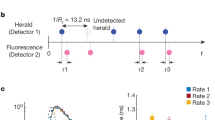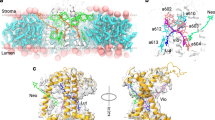Abstract
SPECIES of chlorophyll a absorbing in the red at 673–5, 682–5 and in the range 697–715 nm occur in photosynthetic organisms1. Colloidal dispersions, monolayers spread on water, and various crystalline preparations of chlorophyll are also known to absorb light at wavelengths longer than does monomeric chlorophyll2. The red-shift of chlorophyll in the plant has been explained in terms of an exciton theory3 and is generally considered the result of aggregation or crystallization of the chlorophyll. A large red-shift is taken almost automatically to indicate a high degree of crystallinity4. We have now prepared chlorophyll a solutions and films which absorb in the red at 672–5, 682–5, 710–20 and 740 nm, and have been able to deduce structures for these long wavelength forms of chlorophyll from the infrared spectra.
This is a preview of subscription content, access via your institution
Access options
Subscribe to this journal
Receive 51 print issues and online access
$199.00 per year
only $3.90 per issue
Buy this article
- Purchase on Springer Link
- Instant access to full article PDF
Prices may be subject to local taxes which are calculated during checkout
Similar content being viewed by others
References
Butler, W. L., in The Chlorophyll (edit. by Vernon, L. P., and Seely, G. R.), 343 (Academic Press, New York, 1966).
Clayton, R. K., Molecular Physics in Photosynthesis, 149 (Blaisdell Publishing Co., New York, 1965).
McRae, E. G., and Kasha, M., J. Chem. Phys., 28, 721 (1958).
Rabinowitch, E. I., Photosynthesis, II, Part 2, 1822 (Interscience, New York, 1956).
Katz, J. J., Dougherty, R. C., and Boucher, L. J., in The Chlorophylls (edit. by Vernon, L. P., and Seely, G. R.), 235 (Academic Press, New York, 1966).
Katz, J. J., and Ballschmiter, K., Angew Chem., 80, 283 (1968).
Katz, J. J., Ballschmiter, K., Garcia-Morin, M., Strain, H. H., and Uphaus, R. A., Proc. US Nat. Acad. Sci., 60, 100 (1968).
Olson, J. M., and Stanton, E. K., in The Chlorophylls (edit. by Vernon, L. P., and Seely, G. R.), 381 (Academic Press, New York, 1966).
Jacobs, E. E., and Holt, A. S., J. Chem. Phys., 22, 142 (1954); Jacobs, E. E., Vatter, A. E., and Holt, A. S., Arch. Biochem. Biophys., 53, 228 (1954).
Anderson, A. F. H., and Calvin, M., Nature, 194, 285 (1962).
Tomita, G., Biophysik, 4, 296 (1968).
Sherman, G., and Wang, S. F., Nature, 212, 588 (1966).
Sherman, G., and Linschitz, H., Nature, 215, 511 (1967).
Sherman, G., and Fujimori, E., Nature, 219, 375 (1968).
Litvin, F. F., and Gulyaev, B. A., Dokl. Akad. Nauk, SSSR, 158, 460 (1964); Jacobs, E. E., Holt, A. S., and Rabinowitch, E., J. Chem. Phys., 22, 142 (1954).
Author information
Authors and Affiliations
Rights and permissions
About this article
Cite this article
BALLSCHMITER, K., KATZ, J. Long Wavelength Forms of Chlorophyll. Nature 220, 1231–1233 (1968). https://doi.org/10.1038/2201231a0
Received:
Revised:
Issue Date:
DOI: https://doi.org/10.1038/2201231a0
This article is cited by
-
Improvement of chlorophyll identification in foodstuffs by MALDI ToF/ToF mass spectrometry using 1,5-diaminonaphthalene electron transfer secondary reaction matrix
Analytical and Bioanalytical Chemistry (2015)
-
Study on the biostability of chlorophyll a entrapped in silica gel nanomatrix
Journal of Materials Science: Materials in Electronics (2009)
-
Green thoughts in a green shade
Photosynthesis Research (1990)
-
Molecular symmetry and exciton interaction in photosynthetic primary events
Applied Physics (1975)
-
Chlorophyll interactions and light conversion in photosynthesis
Die Naturwissenschaften (1973)
Comments
By submitting a comment you agree to abide by our Terms and Community Guidelines. If you find something abusive or that does not comply with our terms or guidelines please flag it as inappropriate.



